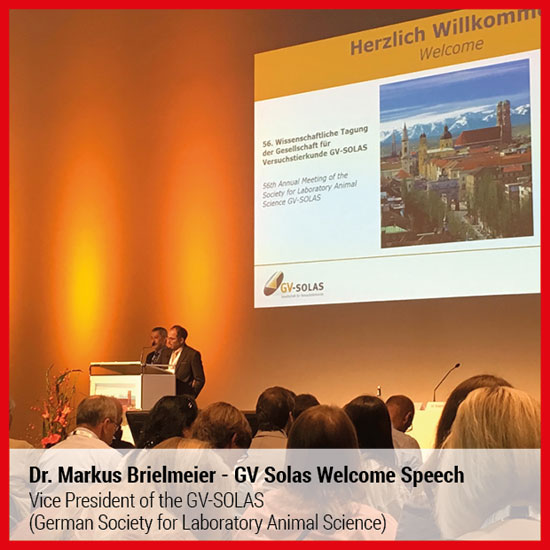
The current version of the Tecniplast website doesn't match your region. Please visit your local website to find information and offerings specific to your country.

The current version of the Tecniplast website doesn't match your region. Please visit your local website to find information and offerings specific to your country.

Panorama editors meet Dr. Markus Brielmeier, Vice President of the GV-SOLAS (German Society for Laboratory Animal Science)
 Dr Brielmeier, you were the “Deus Ex Machina” for the Scientific Program for the 2018 GV SOLAS Congress. Can you list the most important reasons of the success of this Scientific Conference with more than 1160 attendees?
Dr Brielmeier, you were the “Deus Ex Machina” for the Scientific Program for the 2018 GV SOLAS Congress. Can you list the most important reasons of the success of this Scientific Conference with more than 1160 attendees?
Thank you for the compliments. But I’d like to clarify something. This wonderful conference was organized by a whole team, consisting of me and Dr. Brandstetter from the Max Planck Institute as Co-Presidents, an organizing committee from the big universities and scientific organizations in Munich and a large scientific committee from the whole country. The main reason for the success of the conference, and this is the feedback from many attendees, was the excellent program covering hot topics of LAS and the broad spectrum of biomedical research in the area of Munich, one of the most prominent science spots in Europe. Besides the scientific program we had a large number of attractive teaching sessions and workshops, organized by the IGTP which represents animal caretakers and technicians within GV-SOLAS. With the number of attendees we broke all records. This might also be, to some extent, thanks to the very attractive town of Munich.
We heard that the session on Gnotobiotics in different caging systems was great. Can you list the most important reasons and comment on one of the most excellent presentation of this session by Betty Theriault?
Let me first explain why we chose this session. New technologies have enabled researchers to characterize the microbiome and it became clear that it is an important co-founding factor determining disease outcome. Many microbiome studies require gnotobiotic animals. Yet, breeding germfree animals is a complicated and expensive task and few facilities in Germany (and world-wide) are able to do so. Rigid or flexible isolators have been the equipment of choice for decades. Recently, new equipment based on the technology of individually ventilated cages has become available. Betty and the other presenters provided information on gnotobiotics in general, the use of new technologies and on how far the equipment might help more animal facilities to provide gnotobiotic services to their users. We were very proud Betty accepted our invitation. She and André Bleich, who is an expert in the field from Hanover Medical School, gave a general view on the history and current developments and Felix Wolf from Cornell gave his presentation on hands-on techniques directly from his office in New York via skype. We might think about this technical solution in future when presenters aren’t able to travel or to generate a more environmentally friendly footprint when presenters come from overseas.
The interest in gnotobiotics seems to be growing so fast. Do you think the growth will continue?
Yes. The participation at the session was more than 120 attendees. Not enough seats available, people were standing at the back of the room. This illustrates the great interest in the community. Since our attendees were mainly LA veterinarians, facility managers and caretakers, I assume, at their home institutions, as in my institution, urgent demand for gnotobiotic research has been communicated by their users. As a take home message of the session, it became clear that the available IVC systems allow experimentation with mice keeping their microbiological status stable over months. But working with gnotobiotic animals is such a complicated task, that cooperation between (few) sources of germ-free animals, both commercial and universities, and scientists performing experiments with those animals at their home institutions using e.g. dedicated IVCs will be the key to success.
Can you tell us about another very successfull seminar at the 2018 conference from a scientific point of view?
The second session, I was personally chairing, was on hygienic monitoring using environmental samples. All seven speakers reported on studies comparing classical sentinel monitoring to exhaust air particles PCR showing that EAP-PCR gives more detailed and more reliable information. For facility managers thinking about replacement of Sentinels by EAP-PCR it seems to be a reasonable approach to apply both methods in parallel over a few monitoring periods, compare results and see if Sentinels give any additional information at all. Although this approach requires more resources for a short period of time, replacing sentinels has the potential to save money afterwards. In the discussion one point was raised that comes often as a potential drawback of the new technology. If replacing sentinel bacteriology by PCR one might miss bacterial species which are not covered by the PCR primers but would grow on a bacterial plate. This is true, but not very relevant, because the available PCR panels cover the important species and one should always complement EAP-PCR, which is a screening method, by examination of sick or conspicuous animals. In such case bacterial culture, serology and PCR are still the methods of choice.
You mentioned hot topics of LAS. Can you specify?
Some of the hot topics covered by the program were “talking to the public about animal experimentation”, severity assessment, including two FELASA train the trainer workshops, the “reproducibility crisis” and large experimental animals. In the opening lecture, Eckhard Wolf from the Ludwig Maximilians University Munich explained to the audience the concept of one health which was the principle motto of the conference. Coming originally from the field of zoonosis, ONE HEALTH covers the relationship of humans, animals, plants and the environment when it comes to diseases. He is highly active in the field of xenotransplantation. As an example how most of these factors play a role in many biomedical fields he described progress in the field of pigs a donors of organ transplants.
Could you give a feedback on your experience as organizer of such a big congress?
It was hard work for all of the organizing and scientific committee to organize the event. Fortunately, the GV-SOLAS partners with a very competent congress agency and we have a road book for conferences based on former events. My personal resume is very positive. You can learn a lot and look beyond your own nose.
Leopoldo ZAUNER – Marketing Director